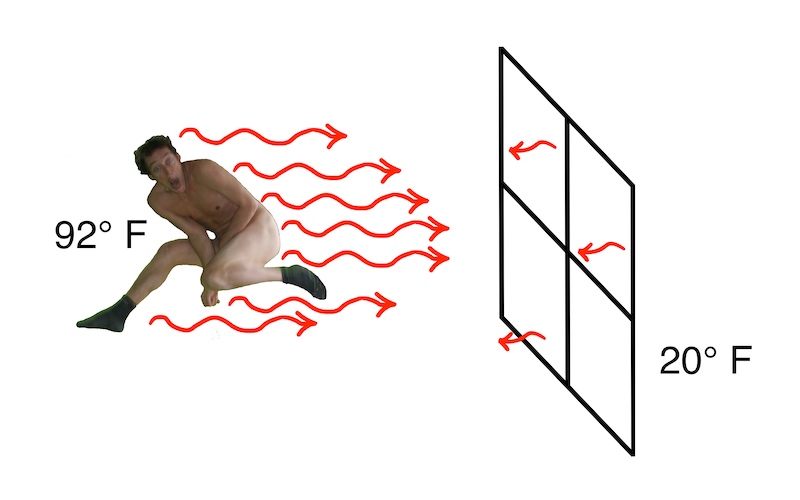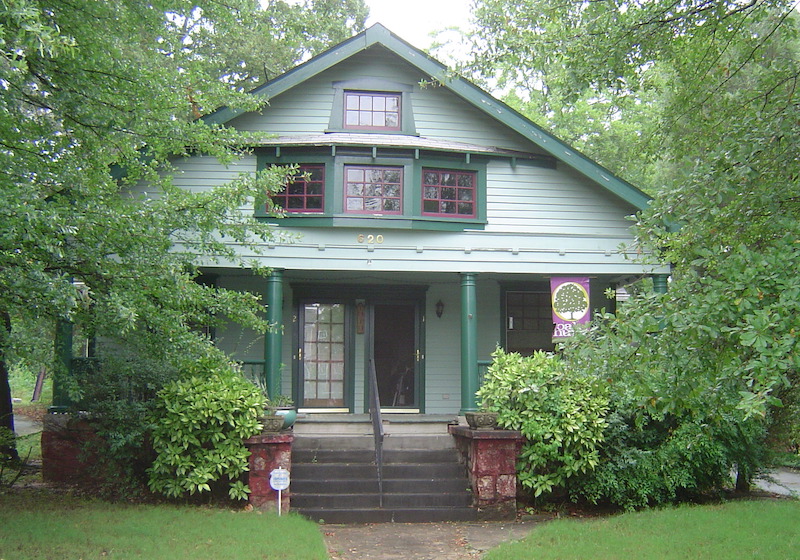Naked People Need Building Science

Don’t you just love to strip down to your socks and jump on the bed? As a kid, you may not get away with it, but you’re a grown man or woman now, so who’s to stop you? And then, when you’ve exhausted yourself, you can walk naked to the kitchen to get a glass of water. You can sit down au naturel and check your email or update your Facebook page, maybe even write a blog article.
Later, after you’ve cooled down from your exercise on this cold December day, you start feeling the chill. Hmmmmm. The thermostat says it’s 70° F in the house, so why are you cold?
The answer to your discomfort lies in building science. Comfort depends, of course, on personal factors—metabolism, activity, the hot flashes of menopause, clothing—but four external factors affect your comfort as well. (I wrote about these four factors of comfort a while back.)
The one that gets all the attention is air temperature, but that’s not the operative factor for unclad folks in homes with weak building envelopes. Convection could be one, as drafts cause air to move over bare skin, cooling it down. Even without drafts, though, the disrobed can be cold. It has to do with this thing called mean radiant temperature. Here’s how it works.

Every object radiates heat. The amount of radiant heat it gives off depends on its temperature (to the 4th power!), surface area, and emissivity. So our naked man jumping on the bed in front of the single pane window is giving off not only more views than he’s getting back but also more heat. The surface of the window is much colder and gives off far less heat, so the net flow of radiant heat is away from the man in his birthday suit. He’s cold! (And none of us needs reminding what George Costanza said about cold men. Oh, wait, I guess I just did remind you.)
In your home, there are surfaces all around you, and they have a big effect on your comfort, whether you’re in the raw or not. You’re giving off heat, and so are they. If they’re cooler than you, you lose heat. If they’re warmer (think bonus room in summer), you gain heat. If you keep the air temperature at 70° F in winter, the closer your walls and windows are to that temperature, the more comfortable you’ll be.

Obviously, a home with single pane windows and uninsulated walls, like the old house where I once lived (above), will have colder surfaces. On cold days, you feel the chill almost as soon as the heat goes off because those surfaces quickly suck the heat right out of your body. That’s why insulation and air sealing is so important. A good building envelope is critical to comfort, especially for the threadbare, but even when you’re dressed, you don’t want to lose excess heat to a bad building enclosure.
For those of you who want a more rigorous, mathematical look at this topic, check out the Healthy Heating page on mean radiant temperature. The Healthy Heating website and blog, written by engineer Robert Bean, is a great resource for technical information. Since he’s in Calgary, he knows a thing or two about cold surfaces.
So, the takeaway is that you can enjoy leafless comfort in your home without cranking up the heat to 90° F. You just need to make sure your building envelope has a high enough mean radiant temperature by having good insulation and air sealing. Whether the neighbors will be happy with your level of comfort is another matter, though.
Allison A. Bailes III, PhD is a speaker, writer, building science consultant, and the founder of Energy Vanguard in Decatur, Georgia. He has a doctorate in physics and writes the Energy Vanguard Blog. He is also writing a book on building science. You can follow him on Twitter at @EnergyVanguard.
Related Articles
How Can Replacing a Furnace Make You Less Comfortable?
Thermal Comfort: Everyone Wants It but Few Know the ASHRAE Standard
Photo of naked man by Pixel Addict from flickr.com, used under a Creative Commons license.
NOTE: Comments are closed.
This Post Has 16 Comments
Comments are closed.

Your eample is over the top
Your eample is over the top this time.
Allison, I spent 30 years
Allison, I spent 30 years working with Seniors before becoming a HERS Rater. Not uncommon to enter homes with the stat set at 80. I even had one set at 90. An envelope that held the heat would still be worth it. Thanks for the explanations. They work for me!
Of all the comfort
Of all the comfort improvements homeowner can make, installing Modulating equipment will make the most noticeable difference.
Since calculating loads on old houses is a SWAG at best and even a properly sized single stage unit will be oversized at least 97.5% of the time creating cycling and temperature variations, equipment that produces just the right amount of BTU’s under varying conditions make a tremendous difference.
A two stage AC unit will not only hold to the set point much better, but run on 1st stage as much as 84% of the time and dehumidify much better than any single stage unit ever could, another comfort difference.
If you insulate and air seal my house, you make my oversized equipment more oversized and my cycling, temperature variations, and indoor RH will only get worse.
thanks,
pj
Allison, thanks for that very
Allison, thanks for that very disturbing visual into a bizarre aspect of your personal life (don’t deny the naked guy is actually you! 🙂
Back to the human body and thermal comfort: It intrigues me how properly dressing for outdoor activities in very cold weather (e.g., skiing, running, winter hiking in the mountains) is highly analogous to, and yet handled somewhat differently from, applied building science: 1) You need air sealing, of course, which in this case is provided by a wind proof outer shell, but that shell must be one-way permeable to allow moisture to escape to the outside to keep the insulating layer dry; 2) You need an insulating layer (e.g., fleece or wool), but that insulating layer must retain warmth, while at the same time transporting water vapor through it and outward to its exterior surface; 3) you need a sublayer, which directly removes perspiration from the skin and evaporates it to the insulating layer; 4) As long the skin remains dry, and heat is retained, and no cold air can come in, the winter sportsperson stays warm and comfortable.
So this has me wondering why a wall assembly still hasn’t yet been engineered to perform more like that (unless there are examples I’m just unaware of). While we air seal, we ultimately try to completely block the exfiltration of moisture, often because both our insulating and building materials are compromised by the presence of moisture, rather than simply dispersing it.
Does this argument/analogy seem to make any sense? Or am I missing something?
Phil,
Phil,
I believe in the 2 stage or communicating systems, but without an air barrier any HVAC unit and ductwork is like sitting it out in the backyard trying to change the temperature.
Think of a bon fire on a cold night. If there is an air barrier to contain the heat you have something, or you keep piling wood (fuel) on and enjoy a fraction of the heat your energy is generating.
That’s what your dad was trying to tell you as a kid to “close the door I can’t heat the whole outside”. The door tightly sealed is part of the air barrier.
Thanks,
Gene
I’m with John Poole. I’m
I’m with John Poole. I’m still slightly stunned from the imagery.
You are memorable, if nothing else, Alison. The great thing about owning your own biz is that no one gripes at you for not being PC.
Of course the bad thing about having your own business is that no one edits/censors the boss.
Great article, Allison.
Great article, Allison. Ceiling fans help in summer, not only because they cause evaporative cooling of the skin, but also because they reduce the surface temperature of the ceiling. A slight reduction of the ceiling temperature will have a significant impact on radiant heat transfer to the body, especially when we’re sprawled out horizontally in bed, with more of our surface area exposed to the ceiling. In winter, a ceiling fan will help increase the ceiling temperature. Just make sure to reverse the direction and use the lowest speed to prevent unwanted evaporative cooling.
Great example and article;
Great example and article; both amusing and informational. Please ignore the puritans and keep up the research.
Allison,
Allison,
You have single handedly motivated all the nudists and all the wannabe nudists to collectively improve the performance of their homes AND finally brought equality to the three scantily clad tall Danish ladies who years ago participated in a large thermal comfort research project as recorded by the project photographers. I vote for the new slogan for thermal comfort – “Show your skin”!
…
On behalf of all those who get that air temperature is not a surrogate for thermal comfort, and get the principles of MRT and Operative Temperature – our hats (and shirts, pants and socks) are off in your honor of this new day.
Three cheers *** and a big thank you.
RB
JN: This Buds for you < an article on seniors, long term care and HVAC systems.
, as you mentioned, it is exactly the analogy I use…great minds…
JN: This Buds for you
PJ: Deferring to a famous building scientist who said, “one can pick ones nose, pick ones teeth or scratch ones rear, and the significance of the order is not a trivial matter.” You are correct, upgraded and right or oversized HVAC equipment becomes oversized or more oversized when the building loads are reduced…the effects of said oversized equipment is the fodder for ongoing debates around the industry. Maybe Allison can expose this topic further…
JP: If you don’t mind waiting for the 120 second upload, see slide appx. 19 from this ASHRAE SAC Lecture
DB: A significant amount of our work lately on SSPC 55 is on elevated air speeds for thermal comfort in hot climates and naturally ventilated air spaces; and in fact there is a new graphic in the 55 Standard to illustrate these conditions. Also elevated air speeds have also been updated in the ASHRAE 55 Thermal Comfort Software Tool.
Sweeeet little home is almost
Sweeeet little home is almost as endearing as jumping jack flash.
Thanks for all the great
Thanks for all the great comments. Just in case you’re wondering, that’s not me in the photo at the top. Evidently, some people suspected that it was. Nope. Just some random dude from flickr.com.
David B,
David B,
Interesting take on ceiling fans in winter… I hate any air movement in winter I don’t care how slow the air speed is. When you reverse the fan doesn’t it bring cool air from the floor up and cool the ceiling???
Chad:
Chad: Granted, any winter benefit will be small, perhaps not worth talking about. But the idea is to ensure that the warm supply air from the registers reaches the ceiling. In the case of radiant heat, ceiling temperature may not be an issue, but a fan will help in a different way — by disrupting stratification.
Personally, when in bed, I like to feel slight air movement on my head in the winter. But if air movement bothers you, then don’t use a fan.
David/Chad – Claiming ceiling
David/Chad – Claiming ceiling fans are good for more than evaporative cooling requires case by case.
“Theoretically” it cools the ceiling – assumes the ceiling is hot which is often NEVER the case, certainly not ALWAYS the case.
“Theoretically” it mixes stratification. Given high delta heat sources are less and less common, this is legacy thinking much more appropriate to 1970’s heating than 2012.
(I have a client who spray foamed his attic. When he heats with his oil furnace the house is colder the higher he gets, and the unintentionally conditioned attic temp is between home and outdoor temp. When he heats with his wood stove the reverse occurs. It get’s warmer as he goes up with his unintentionally conditioned attic reaching sauna-like temperatures.)
Ted, it only takes a few
Ted, it only takes a few degrees of difference for ceiling to become a radiant heater, so no, the ceiling doesn’t need to be hot for a ceiling fan to provide this additional benefit.
Regarding winter use of fans, as I said, the benefit is small, but it’s useful to understand why there’s a benefit at all.